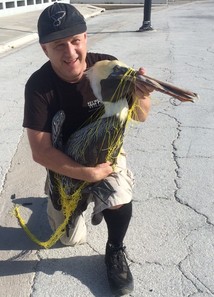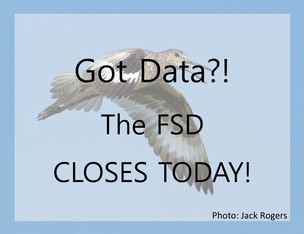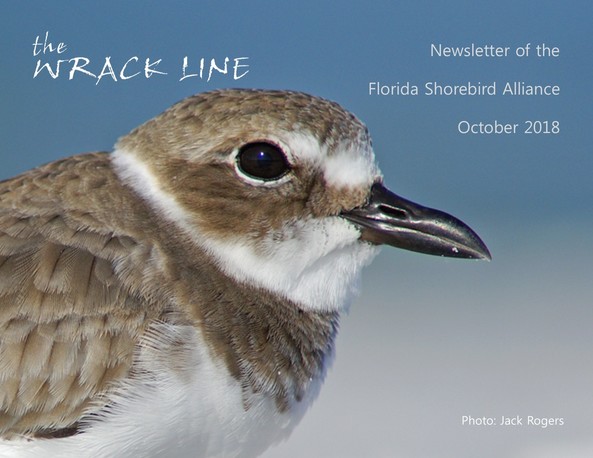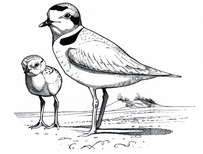FSA Partnership Meetings:
October 4: Panhandle Working Group in Panama City. Contact FSA Coordinator.
October 4: Suncoast Partnership, 12-2 pm, Eckerd College. Contact Beth Forys.
October 4: Volusia Partnership, 9am-12pm, Beach Safety HQ, Daytona Beach. Contact Jennifer Winters.
October 9: Lee/Collier Partnerships, 1-4:30 pm, Rookery Bay ELC. Contact Adam Dinuovo.
October 10: Southeast Partnership, 1-3pm, location TBD. Contact Natasha Warraich.
October 11: St. John's/Flagler Partnership, 1-4pm, St. Augustine Alligator Farm. Contact Chris Farrell.
October 15: Florida Keys Partnership, 1-3pm, Marathon Gvt. Center. Contact Tom Sweets.
October 22: Treasure Coast Partnership, 1-3pm, Savannas Preserve State Park. Contact Dan O'Malley.
October 23: Timucuan Partnership, 10am-1pm, Ribault Club, Jacksonville. Contact Blair Hayman.
October 25: Nature Coast Partnership, 1-4pm, Withlacoochee Gulf Preserve (new location). Contact Megan Wallrichs.
October 25: Space Coast Partnership, 10am-12:30pm, Kiwanis Island Park, Merritt Island. Contact Anna Deyle.
Events:
October 1: Florida Shorebird Data Entry Deadline
October 11-14: Florida Birding & Nature Festival
October 19-20: Florida Audubon Assembly
 Partner Spotlight: Tom Sweets of the Florida Keys Shorebird Partnership
The Florida Shorebird Alliance (FSA) is a statewide network of local partnerships that work to advance shorebird and seabird conservation across the state. The success of the FSA depends on the hard work and dedication of countless individuals. To thank our partners for all you do, the Wrack Line will now feature a partnership in each newsletter. We begin with a big "Thank You" to Tom Sweets of the Florida Keys Partnership.
Tom Sweets, the executive director of the Key West Wildlife Center, spends his days treating injured wildlife, fundraising, and interacting with the public. He also serves as the leader of the Florida Keys Shorebird Partnership where he schedules twice-yearly meetings, keeps partners informed on updates, and ensures that all known nesting sites are monitored during nesting season. Tom and his staff at the Wildlife Center monitor most of the 14 rooftops nesting colonies in the Key West area. He rescues least tern chicks that have fallen from rooftops, returning them to the rooftop if they are uninjured. He reaches out to property owners and managers to let them know about rooftop nesting activity and the protected status of the birds.
During nesting season, the area species conservation biologists with the Florida Fish and Wildlife Conservation Commission often receive reports of possible violations occurring on rooftops with nesting least terns. It is important to respond to these reports as quickly as possible to prevent any negative impact on the birds; however, it is not always possible for the biologists, based in Palm Beach County, to visit all sites immediately. When the biologists receive calls from Key West, they know they can depend on Tom to help. Tom is always willing to visit these rooftops when asked. He often goes out of his way to promptly provide detailed observations to the biologists. This quick response allows for proper action to be taken to protect the nesting birds.
Tom Sweets works tirelessly to protect and ensure the safety of wildlife in Key West. He is always happy, cheerful, and willing to help. The wildlife of the Lower Keys, especially shorebirds, are fortunate to have Tom watching out for them and the Florida Shorebird Alliance is lucky to have him as part of our team too!
|
Special Report: Red Tide and Birds
Michelle van Deventer
For most of this year, coastal areas of southwest Florida have been experiencing a severe harmful algal bloom (HAB, or “red tide”). The species responsible for these conditions is Karenia brevis, a microscopic marine dinoflagellate. Karenia brevis is named for FWC-FWRI scientist Dr. Karen A. Steidinger in recognition of her research on the organism and associated blooms.
Karenia brevis is primarily found in the Gulf of Mexico along the West Florida Shelf. Physical factors, such as upwellings and currents, play a significant role in the initiation and propagation of blooms. Most blooms begin offshore away from inputs of coastal nutrients, and transport is largely influenced by physical and chemical conditions, such as wind, currents and salinity. Blooms have occasionally been transported by the Loop Current and Gulf Stream from the Gulf of Mexico to the east coast of Florida, as far north as the mid-Atlantic.
Blooms of K. brevis have been historically reported in the Gulf of Mexico since the mid-1800’s. Formal investigations began more than 50 years ago, and localized, short term blooms have been documented almost annually. Larger or more intense blooms have occurred on a cycle of every 3–5 years. Blooms of extreme intensity are described in literature from the 1940s, 1970s, 1990s, and most recently during an event in 2005-06. The 2005-06 event lasted over a year, impacted almost the entire west coast of the state, and resulted in a 2,000 square mile “dead zone” of hypoxic and anoxic water.
Karenia brevis produces a suite of toxins known as brevetoxins, of which there are over a dozen metabolites or derivatives of varying toxicity. Brevetoxins are potent neurotoxins that bind to the sodium channels of nerve and muscle cells, causing them to become “hyperactive”. Neurotoxic Shellfish Poisoning (NSP) is caused when people consume shellfish that have filter-fed toxic K. brevis cells and internally stored the brevetoxins. The State of Florida monitors shellfish beds during red tides and manages them accordingly to prevent NSP incidents. Brevetoxicosis is known to cause illness and death in invertebrates, fish and wildlife, including marine mammals, sea turtles, and birds. Land animals, such as raccoons and coyotes, have also been sickened after consuming red tide-killed fish washed up onshore. Birds may be exposed to toxins through their diet or suffer from reduced prey availability during extended bloom conditions. Red tide conditions may also leave birds more vulnerable to other threats, such as parasites or migratory exhaustion.
The fate and effects of brevetoxins in the food web are complex and continue to be investigated by FWRI’s HAB lab. Not all species are affected equally, and there are often lag-times between the onset of bloom conditions and observed mortality or morbidity in wildlife. Debilitated or dead fish-eating birds, such as cormorants, pelicans and gulls are typically reported in the greatest numbers during a red tide. But the timing of the blooms can be a key factor in impacts to birds. A bloom that coincides in timing and location with migration may result in a single-species mortality event. This was observed in 1974 when thousands of dead and dying lesser scaup were collected during a red tide in Tampa Bay. Although highly circumstantial, brevetoxicosis was not proven at the time.
Signs of red tide poisoning in birds can vary by species, but generally include a lack of coordination, failure to fly or stand when approached, and a head tremor or droop. Seabirds and wading birds are most likely to be exposed to chronic or acute levels of brevetoxins through their diet as prey fish can internally accumulate toxins. Some wading birds and seabirds may be able to avoid toxin exposure or respond to reduced prey availability by foraging at freshwater sites. For shorebirds, common prey items such as bivalves and mole crabs can transmit the toxins to birds. Die-offs of these organisms have also been documented during intense blooms. Sandpipers, such as sanderlings and ruddy turnstones, are frequently observed scavenging red tide-killed fish beached on the shore which can also be a source of toxins. Plover species are less frequently observed scavenging dead fish and may switch to mostly insect prey such as beetles and flies.
Perhaps one of the most interesting findings about the history of red tide impacts to birds in Florida occurred in 1989 when a fossil assemblage of marine birds and fish was discovered at a shell excavation pit in Sarasota County that was dated to the late Pliocene (approximately 2 million years ago). The avian fossils were dominated by a single species of extinct cormorant, Phalacrocorax filyawi. Fossils of several other bird species, as well as an extinct species of seal, were also uncovered. Throughout the fossil layers were thousands of bones and scales of marine fish, as well as “abundant cysts of a dinoflagellate species known to produce toxic red tides”, leading to the conclusion that a series of HABs in the Gulf were the source of the mortality. Although K. brevis is not known to produce a cyst, the implicated toxic dinoflagellate, Pyrodinium bahamense, is still present in Florida waters to this day, and can also be responsible for food poisoning incidents and fish and wildlife mortalities.
While red tides have occurred in Florida since before modern development and many blooms initiate offshore away from coastal nutrient sources, K. brevis can use natural and man-made nutrients once present along shore. Efforts to support healthy beaches and coastal areas can help address other threats to wildlife and water quality that may worsen the impacts of red tide or inhibit the ability of populations and systems to recover. Recent investigations into the potential impact of climate change, including ocean acidification and rising temperatures, have suggested that future climate conditions could also worsen K. brevis blooms.
If you find a sick bird during a red tide, or at any time, find the closest licensed rehabber by using the FWC Seabird Rehabilitator App online or Download the App to your SmartPhone. Observations of dead birds, either unusual species or cluster of multiple birds in proximity, can be reported to the Wild Bird Die-off Surveillance website or the FWC Reporter App.
If you are a rehabber and need more information, contact Lisa Shender at FWC-FWRI Wildlife Health or Michelle van Deventer.
 Black Skimmers and
the Importance of Banding
Adam DiNuovo
The black skimmer banding project started in 2015 in Pinellas County and in 2017 in Collier County, and continued this summer. In addition to the plastic field readable bands, we are now attaching small radio transmitters to a subset of the banded birds. These transmitters are glued to the birds back and fall off when the chick molts its feathers. The tags each have a unique frequency and are detected by special receiving towers placed throughout the state. While we are getting very interesting data from band resighting, we hope that detection of these tags will help us fill in gaps in black skimmer movement in Florida.
What we hope to learn from banding data:
- Which habitats are important for black skimmers outside of the breeding season
- Survival of fledges and adults
- Age at which the birds breed and natal site fidelity
- Movement patterns outside of breeding season
- Do they mate for life or for the season?
Why banding projects like these are critical:
While basic monitoring projects help us determine overall productivity and show population trends, individually marking birds is necessary to assess the health of our beach nesting bird populations. The number of breeding pairs and number of young fledged does not necessarily tell an accurate story. By banding chicks we can determine juvenile survival. Fledging is essential but we also need to know how many fledglings survive to breeding age. By banding birds over several years we can determine the age structure of our populations. It is critical that we have young birds to replace older birds who either die or are no longer part of the breeding population.
Banding also allows us to look closer at bird movement and which habitats are critical outside of the breeding season. By following individual birds over time we can also determine if individuals from different breeding colonies show differences in movement and habitat usage. Insights into movement and habitat use can help inform our management strategies.
Stresses not visible to the naked eye can also be found through banding projects. Several measurements are taken while banding a bird and these measurements could be a red flag to something going wrong in the environment. We saw this in Collier County this season. The vast majority of black skimmer chicks banded on Marco Island this season were extremely underweight when compared to chicks of similar size banded last year. One possible reason could be red tide reducing prey abundance, but we need more data before a cause can be determined. No matter the cause, banding and measuring the birds alerted us to this issue and it is being investigated.
|

 Last call for data entry! Today is the final day to enter your 2018 breeding season data into the Florida Shorebird Database.
If you have any questions or need assistance, please reach out to your partnerships or email us. We are more than happy to help along the way. As always, if you experience any malfunctions with the FSD website, we encourage you to report them. Your feedback helps us create a better website!
Completing data entry today makes it possible for YOUR data to be included in summaries for post-season partnership meetings, and into our long-term analyses.
Data entry checklist:
- My route surveys (even when I didn’t see nesting birds)
- My shorebird nests (plovers, oystercatchers, killdeer, stilts, willets)
- My seabird colonies (terns, skimmers, gulls, pelicans)
- Roving chick sightings for shorebird chicks out of their nests, and seabird young away from their colonies
- All rooftops (even those without birds this season)
Thank you for being an essential partner in the shorebird monitoring program!
|
 Untangling Two Pelicans
Paula Grendel
It's always a good day when you can be part of an animal rescue! Recently, while conducting a nonbreeding shorebird survey, Christopher Lipps and I saw two struggling brown pelicans from afar. As we approached, we realized that the two birds were tangled together in fishing line. One pelican was hooked in the pouch and the other pelican had its leg and wing twisted in the monofilament. Both birds tried to free themselves by pulling in different directions, however that just worsened their situation and added to their exhaustion.
Fortunately, we were able to secure both the birds and assess the situation. It took some effort to get the hook out of the birds pouch and remove the long line wrapped around the leg of the other pelican, but when all was done they were in considerably good shape. It was an amazing feeling to watch these two push of the sand and fly over the Gulf.
These two pelicans are considered the lucky ones. Entanglement of birds and other wildlife in discarded fishing lines, plastic bags and other garbage is unfortunately an all too common occurrence. It's not always easy to help an animal that has been caught in litter because they are often wary, frantic, or they try to elude people.
So, what are a few things you can do to prevent injury and entanglements: Properly dispose of fishing line and lures; cut all loops of packing bands and lines; remove trash and fishing line/lures from the beach; and never release helium balloons outdoors.
Learn more at Don't Cut the Line!
|
 Christopher Lipps of Audubon Florida calmly works to free two pelicans from fishing line entanglement. Both birds were successfuly freed thanks to the work of local shorebird biologists.
|









